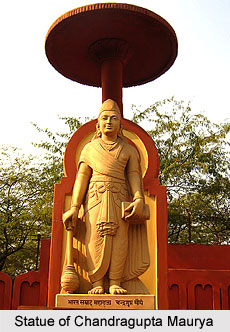 According to Megasthenese, Chandra Gupta Maurya had a big and powerful army of 60,000 infantry, 60,000 horsemen, 3,000 chariots and 9,000 elephants. The army was efficiently organized by a council of thirty members, which was further divided into six boards of five men each.
According to Megasthenese, Chandra Gupta Maurya had a big and powerful army of 60,000 infantry, 60,000 horsemen, 3,000 chariots and 9,000 elephants. The army was efficiently organized by a council of thirty members, which was further divided into six boards of five men each.
These boards were as follows:
• Board for infantry: It was responsible for infantry and organized its affairs
• Board for cavalry: It looked after the horsemen and its chief was called `Asva ghasosah.`
• Board for chariots: Rathadhayaksha was the in charge of this board, which managed the war chariots.
• Board of elephants: Its in charge was called `Hasth-adhyaksha.` It was a very powerful branch of the army. Three archers used to sit on one elephant.
• Board for navy: `Navadhayaksha` was the chief of this board that supervised the boats and ships that were used for the purpose of assisting in arresting pirates. Taxes were also collected from the merchants by this board.
• Board for managing transport: This board was responsible for all the affairs relating to military transport. The state maintained a large number of bullock carts known as `transporting engines of war.`
All the soldiers were paid regular salaries, which were sufficient to enable them to lead a comfortable life. During the wartime the soldiers fought vigorously without caring for their lives, but in peaceful time they were allowed to entertain themselves. Another significant aspect in the organization of the army of Chandra Gupta was the different type of forts and different strategic places. Besides this there were several factories for the production of the arms of different kinds. While comparing the organization of the army of Chandra Gupta Maurya with other kings of India V.A. Smith has observed.
"Chandra Gupta Maurya maintained a huge standing army directly paid by the crown an instrument of the power infinitely more efficient than Akbar`s militia which failed miserably when confronted with small Portuguese forces, whereas the Mauraya`s was more than a match for Salukus.



















